#pannonica de koenigswarter
Photo

「爵和尚吃蘋賜福圖」
Thelonious Monk eats apple
West 63rd Street, NY.
Photo: Pannonica de Koenigswarter
2K notes
·
View notes
Text




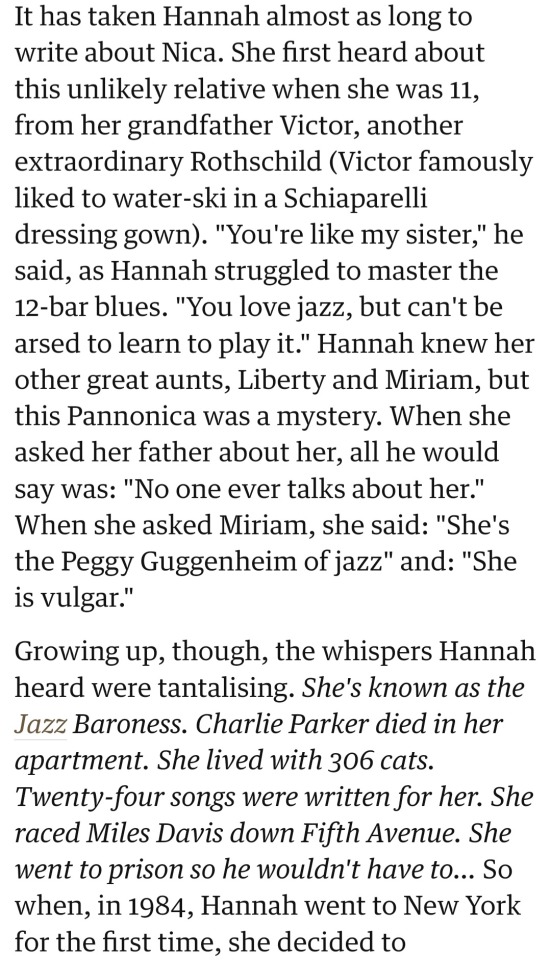
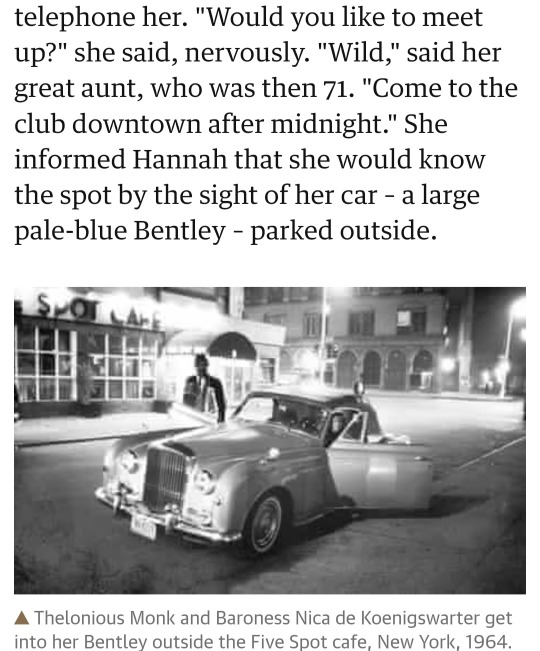




Nica's father was Charles Rothschild. Like his zoologist father, Walter, who turned the grounds of Tring into an extraordinary wildlife park with kangaroos, giant tortoises, emus, rheas and cassowaries, and who drove a carriage pulled by zebras, Charles had a passion for natural history. He was a keen amateur entomologist and named his youngest daughter Pannonica for a species of moth. However, this was not an interest he was free to pursue. Instead, every day, he was required to put on a suit and go to work in the family bank. This did not suit him one bit.
Charles also suffered from a mood disorder that may or may not have been schizophrenia. At times, he would not speak for days. On other occasions, he was manic, unable to sleep or stop talking. As he grew older, the gaps between these episodes grew even shorter. Finally, in 1923, he went into a bathroom, locked the door and slit his throat with a knife. Hannah believes that Charles's suicide lies at the heart of Nica's unlikely bond with Monk, who suffered from a similar illness, with similarly debilitating symptoms.
"Her father's death was incredibly violent, but afterwards it was never mentioned: suicide was still illegal. When she met Thelonious, there must have been huge resonances. He behaved in a very similar way to Charles, and Charles had been made to live a certain kind of life, going to the office every day, when what he wanted to be doing was collecting butterflies. Her passionate attempts to dignify Thelonious's life, to protect him, to say it's alright to spend the day sleeping if that's what you want or need to do...I'm sure this was her way of addressing an earlier injustice. In return, he gave her an incredible sense of purpose and belonging. If you think of her as a woman who'd been evicted from a close family, that's quite a frightening thing. But Thelonious and a whole group of musicians said to her: come and be part of this. We'll hang with you." Monk wasn't the only one who wrote a song for Pannonica. So did Art Blakey, Sonny Clark, Kenny Drew and at least a dozen others.
But life in New York had a dark side, too. In 1955, Nica was evicted from her suite at the Stanhope when Charlie Parker, having turned up at her door one night with nowhere else to go, choked and died there. In 1958, Nica decided to drive the impoverished Monk to a gig in Maryland. In a town called New Castle, Delaware, she stopped the car outside a motel so he could use the bathroom. As she waited, the police approached; in this part of America, the sight of a white woman and black man together was unusual enough to attract attention. There followed an altercation. Monk was beaten up. The police searched the car. When they found marijuana, Nica knew exactly what to do. Monk was too fragile to go to prison. She told them that the dope was hers.
The consequences of this moment of bravery were potentially dire. Nica faced a prison sentence of up to 10 years, followed by immediate deportation. Her life with Monk would be over, but the prospect of a return to England was just as painful. How would her family react? Would her husband ever let her see her children again? "It must have been terrifying," says Hannah. "I finally found out how terrifying in a letter she wrote to her friend Mary Lou Williams the night before her trial in January 1962. She is in Delaware. She writes that she is going to go into a church and light a candle. She writes, 'This is the day upon which my entire future may well depend.' She says she can't talk to Thelonious or Nellie about it because they have their own worries. She was so completely alone. I felt quite distressed on her behalf. Where is everyone? I thought." In the end, though, there came a miracle: the case was dismissed on a technicality, her lawyer arguing that the troopers had searched her car without her permission.
12 notes
·
View notes
Text

Thelonious Monk and a siamese kitten by Pannonica de Koenigswarter
#not the stones#I wish the quality were better#but it's too cool (and cute) not to share#thelonious monk#Pannonica de Koenigswarter#jazz#jazz history
15 notes
·
View notes
Text

Pannonica de Koenigswarter, Thelonius Monk, Manhattan
78 notes
·
View notes
Text
The Baroness of Jazz
By Barry Singer
Oct. 17, 2008
IF the mysterious Baroness Pannonica de Koenigswarter is at all remembered today, it is for her proximity to the deaths of two legendary jazz musicians. In 1955 Charlie Parker died on a sofa in her Fifth Avenue home; 27 years later Thelonious Monk died after secluding himself for years in her New Jersey house.
Both deaths made the baroness an immediate target of tabloid headlines and a long-term subject for scurrilous gossip. Almost no one, though, beyond the insular jazz world, could possibly know her whole story: how, until her death in 1988, she championed jazz as both a friend and a generous, if rather unlikely, benefactor.
A Rothschild heiress, she offered her home to countless jazzmen as a place to work and even live, while quietly paying their bills when they couldn’t find work. She chauffeured them to gigs around New York, toured with them as a kind of racial chaperon, and was even known to confront anyone she felt was taking advantage of her friends because they were black.
“I always likened her to the great royal patrons of Mozart or Wagner’s day,” the saxophonist Sonny Rollins said in a telephone interview. “Yet she never put the spotlight on herself. I try not to talk publicly about people I knew in jazz. But I have to say something about the baroness. She really loved our music.”
The baroness first materialized in New York jazz clubs in the early 1950s like some film noir siren, right down to the raven hair and long cigarette holder. She seduced the music’s greatest figures with her friendship, the revolutionists of the bebop era: Charlie Parker, Dizzy Gillespie, Miles Davis, Thelonious Monk and many others. Her illustrious family has long refused to discuss her. But now a new book, “Three Wishes: An Intimate Look at Jazz Greats” (Abrams Image), offers a window into her personal life, providing details even her jazz intimates were probably unaware of.
The book is primarily a collection of candid photographs of the musicians taken by the baroness, and a compilation of their varied responses to a favorite question: “What are your three wishes?” On Oct. 30 an exhibition of her original notebooks collecting these snapshots and wish lists will open at the Gallery at Hermès in New York.
“Three Wishes” arrives with the implicit sanction of the Rothschild family, including a six-page introduction by a granddaughter, Nadine de Koenigswarter. The book offers more concrete information about the baroness than has ever before appeared between covers. But the source of her extraordinarily deep bond with jazz musicians remains elusive.
She was born, her granddaughter writes, in London on Dec. 10, 1913. Her full name was Kathleen Annie Pannonica Rothschild, according to her 1935 wedding announcement in The New York Times. She was the granddaughter of Nathan Mayer, the first Lord Rothschild, and the great-granddaughter of Mayer Amschel, the Rothschild patriarch who, from the Frankfurt ghetto, orchestrated his family’s rise. Her father was Nathaniel Charles Rothschild, a partner in the family bank, whose greater passion was entomology, a hobby at which he was both gifted and exceedingly accomplished. According to a great-niece, Hannah Rothschild, who is completing a documentary about her for the BBC, the baroness’s father was plagued by clinical depression that sometimes led the family to hospitalize him. He killed himself in 1923, at 46.
Nica Rothschild, as she was known, became an aviation enthusiast and an accomplished pilot. At 21 she met a kindred spirit at Le Touquet airfield in France. Baron Jules de Koenigswarter, 31, was a French mining engineer, banker and pilot. He was also a widower with a young son, and like Nica, he was Jewish. The baron quickly proposed after just three months; her response was flight to New York. They were married at City Hall in October 1935.
The couple took up residence in Abondant, a 17th-century chateau not far from Normandy. Their first-born child, Patrick de Koenigswarter, recalled in May in an interview published in The National, an Abu Dhabi newspaper, that when the Nazis invaded France, the baron, a lieutenant in the reserves, was called up. His father “left my mother a map, with instructions: If the Germans get to this point, take the children and escape any way you can to your family in England.” Shortly thereafter, his mother did, accompanied by a nanny and a maid, on what proved to be the last train out of Paris. The baron’s mother dismissed her son’s entreaties and instructions. She died at Auschwitz.
The baron joined de Gaulle’s Free French forces and was assigned to the Congo. At his instigation his wife next moved their two children to the United States, placing Patrick de Koenigswarter and his younger sister, Janka, with the Guggenheim family on Long Island. The baroness then somehow rejoined her husband in Africa with the Free French, serving in various capacities including ambulance driver and ending the war as a decorated lieutenant.
One little-known wartime detail lends a different sense to her later arrival in the New York jazz world. Her husband’s extended family, as well as her Hungarian-born mother’s, were nearly all killed in the Holocaust. The baroness’s adoption of New York’s predominantly black jazz family in the war’s aftermath thus seems less the act of a louche dilettante than of a survivor bent on resurrection and rebirth.
“I believe that she could no longer live in any ivory tower after what she saw in the war,” Hannah Rothschild said in a telephone interview. “Privilege offered no protection. The fate of her own mother-in-law proved that. She had experienced the very depths of prejudice herself firsthand.”
The baron entered the French diplomatic service after the war, settling his wife and children first in Norway and then in Mexico. “My father was a very controlling person,” Patrick de Koenigswarter said. “He was adamant about punctuality, while Nica was notorious for being late. She missed appointments, sometimes by days.” He continued, “It didn’t help that my father had no particular interest in the subjects that fascinated her: art and music.”
The baroness always credited her brother, Victor, a jazz fan and amateur pianist who studied with Art Tatum and Teddy Wilson, with introducing her to jazz. Shortly before her death, though, she revealed in a rare interview for the Monk documentary "Straight, No Chaser" the moment when her interest in jazz music escalated into something more.
“I was in the throes of the diplomatic life in Mexico,” she remembered of the years 1949 to 1952, “and I had a friend who got hold of records for me. I used to go to his pad to hear them. I couldn’t have listened to them in my own house, with that atmosphere. I heard them and really got the message. I belonged where that music was. This was something I was supposed to be involved in in some way. It wasn’t long afterwards that I cut out.”
It is well known in jazz circles that the great project of the baroness’s life was the torturously unstable Monk, whom she served as a surrogate wife right alongside Monk’s equally devoted actual wife, Nellie. The baroness paid Monk’s bills, dragged him to an endless array of doctors, put him and his family up in her own home and, when necessary, helped Nellie institutionalize him. In 1958 Monk and the baroness were stopped by the police in Delaware. When a small amount of marijuana was discovered, she took the rap for her friend and even served a few nights in jail.
People have always asked why. What drew her to him so intensely? Was it sex, drugs or groupie-esque infatuation? Clearly her steadfast devotion to Monk’s music propelled their relationship, which both maintained was platonic. In light of her father’s history, though, it seems possible that the underlying bond was love and childhood loss. In Monk, she may have been drawn to the same anguished brilliance that had consumed her father, whom she could not save.
he introduction to “Three Wishes” still leaves unanswered many questions that pursued the baroness throughout her life. Did she abandon her children in her headlong embrace of the jazz life, or were they taken from her? Did she enable addiction in the musicians she loved? Did she buy them drugs? Did she use drugs herself?
These questions once loomed large in her mystique. As her back story deepens, however, their sense of enormity recedes. The baron divorced his wife in 1956 after the scandalous publicity surrounding Charlie Parker’s death in her home. Shaun de Koenigswarter, the couple’s youngest son, recently confirmed that the baron also got custody of the three younger children, Berit (born in 1946), Kari (1950) and himself (1948). “I am the only child who never lived with my mother after she settled in New York in 1953,” he said in an e-mail message, adding that his four siblings lived with her during different periods.
That the baroness in fact lost custody of her three youngest children as a consequence of her love of jazz further illuminates the maternal quality of her presence on the scene. Is it any wonder that she clung to her musicians like family?
“She realized that jazz needed any kind of help it could get,” Mr. Rollins said, “especially the musicians. She was monetarily helpful to a lot who were struggling. But more than that, she was with us. By being with the baroness, we could go places and feel like human beings. It certainly made us feel good. I don’t know how you could measure it. But it was a palpable thing. I think she was a heroic woman.”
It has taken the actual family she left behind a long time to arrive at a similar conclusion. “Not all members of our family were enthused about the life she chose to lead (especially our father!),” Shaun de Koenigswarter wrote. “But over the years, many of those who had initially disapproved particularly in light of the many viciously biased and racist press reports about her came to understand and appreciate what she was all about.”
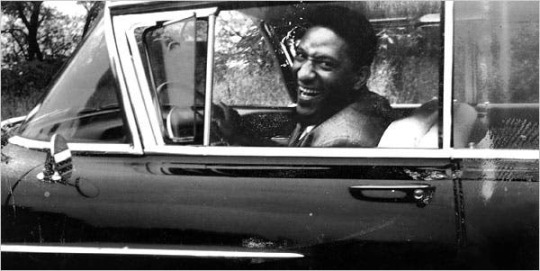
The saxophonist Sonny Rollins, photographed by Pannonica de Koenigswarter.
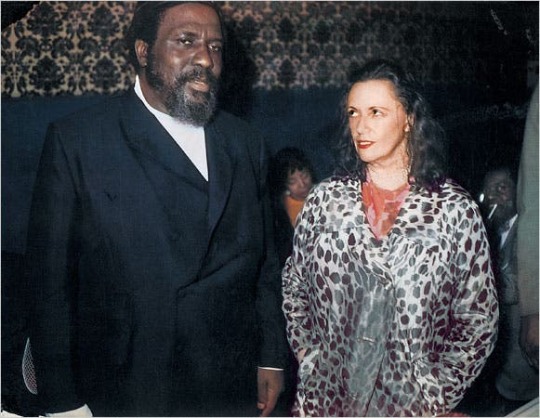
Thelonious Monk was among the many jazz musicians befriended (and photographed) by Pannonica de Koenigswarter, right.

Thelonious Monk by Pannonica De Koenigswarter
youtube
youtube
youtube
2 notes
·
View notes
Text
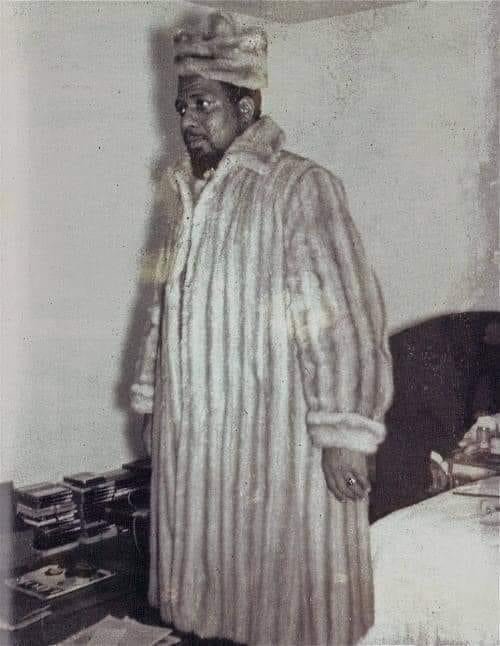
Neat photo of Monk. NYC 1950s, photo by: Pannonica de Koenigswarter
7 notes
·
View notes
Text
1955 (and then some)
1955 (and then some)
In 1955 Charlie Parker died in the suite of a Rothschild, Baroness Pannonica de Koenigswarter, at a hotel in New York City. He was watching TV. The Dorsey Brothers’ Stage Show was reportedly on.
Although the brothers, Jimmy and Tommy, had their biggest period in the first half of the 1930s, TV needed content in its nascent period, so musical variety was big then. Parker was a fan of Jimmy’s…

View On WordPress
#Beach Boys#Bill Haley#Brian Wilson#Charlie Parker#Glen Campbell#James Dean#John Wayne#Little Richard#Paul McCartney
2 notes
·
View notes
Text
Les substances interdites ont provoqué des scandales et des perturbations dans les concerts de Parker

Charlie a développé une réputation de musicien peu fiable. Pour une dose de « médicament », Parker jouait dans la rue pour demander l'aumône ou mettait son saxophone en gage dans un prêteur sur gages.
En 1948, Charlie enregistre son mariage avec Doris Green, qui, après la mort du saxophoniste, devient la veuve officielle de Parker. Cependant, la véritable épouse du musicien au cours des 5 dernières années de la vie de l’homme était Beverly Dorothy Berg, connue sous le pseudonyme de Chan.
Charlie a rencontré une jolie jeune fille juive de 18 ans qui travaillait comme danseuse dans une boîte de nuit en 1943, mais le gars et la fille sont restés longtemps amis. La belle a réussi à donner naissance à une fille, Kim, d'un autre musicien de jazz et était mariée à un autre jazzman nommé Richardson avant de se réunir avec Parker.
Chan a donné naissance aux deux enfants de Charlie, un fils, Baird, et une fille, Pri. La mort du bébé au début de 1954, à l'âge de trois ans, fut un coup dur pour Parker et le renvoya à la dépendance à l'héroïne dont il s'était débarrassé. Charlie a survécu à deux tentatives de suicide.
Chan décrit sa vie personnelle dans le livre « My Life in E Flat », qui a servi de base au biopic de Clint Eastwood « Bird ». Le rôle de Parker dans le film biographique a été joué par Forest Whitaker.
La vie du jazzman s'achève le 12 mars 1955 à l'hôtel Stanhope dans des chambres louées par la baronne Pannonica de Koenigswarter. La plus jeune fille du banquier et entomologiste Charles Rothschild a fréquenté Parker.
0 notes
Text
Nica: "The Jazz Baroness”
Baroness Kathleen Annie Pannonica de Koenigswarter, often referred to as Nica or “the Jazz Baroness,” was a prominent figure in the jazz scene and an influential patron of jazz musicians during the mid-20th century. Born on December 10, 1913, in London, England, Nica was a member of the Rothschild banking family.
Nica developed a deep passion for jazz music, particularly bebop, and became a…

View On WordPress
#Charlie Parker#jazz#jazz baroness#jazz music#music#music discussion#Music Education#music of our youth#musician#nica#Thelonious Monk
0 notes
Text

Thelonious Monk & Kareem Abdul-Jabbar, 1966, in the kitchen/green room of the Village Vanguard. Photo by Pannonica de Koenigswarter (the baroness). K A-J was 18.
Credit
Twitter @techdef
0 notes
Text
Baroness Nica de Koenigswarter
Baroness Nica de Koenigswarter
Born in 1913, the former Kathleen Annie Pannonica Rothschild spent her early life in a manner that passed for normal among the girls of her family – brought up in grand English country houses, educated by governesses, presented at court, barred by her gender from working in the family bank, then betrothed to a French nobleman – until a simmering attraction to jazz, already ignited before the war,…

View On WordPress
1 note
·
View note
Text
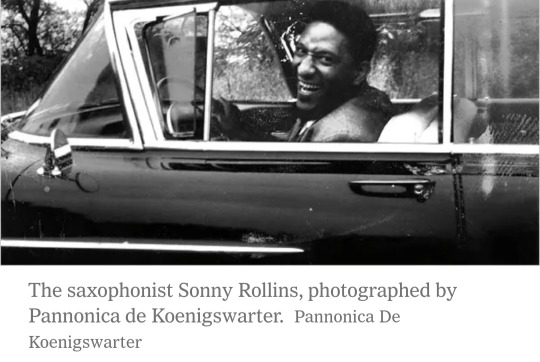
Pannonica de Koenigswarter, a Rothschild heiress, offered her home to countless jazzmen as a place to work and even live, while quietly paying their bills when they couldn't find work. She chauffeured them to gigs around New York, toured with them as a kind of racial chaperone, and was even known to confront anyone she felt was taking advantage of her friends because they were black.
"I always likened her to the great royal patrons of Mozart or Wagner's day," the saxophonist Sonny Rollins said. "Yet she never put the spotlight on herself. I try not to talk publicly about people I knew in jazz. But I have to say something about the baroness. She really loved our music."
2 notes
·
View notes
Text
Pannonica: Tribute To The Jazz Baroness
Pannonica: Tribute To The Jazz Baroness
Price: (as of – Details)
A single moment can change a life forever. That happened to the Jewish baroness and heiress Pannonica (Nica) de Koenigswarter (1913-1988), née Rothschild. On hearing Thelonious Monk’s ‘Round Midnight’ on a trip to New York at the beginning of the 1950s, she was so totally captivated by the music, she turned her back on her native Europe and on all the glamour of her…

View On WordPress
0 notes
Photo

Pannonica de Koenigswarter and Thelonious Monk, playing “Pannonica” with Pannonica’s piano. https://www.instagram.com/p/ChR92iYtV-l/?igshid=NGJjMDIxMWI=
1 note
·
View note
Text
La Baronne Pannonica de Koenigswarter (3/4) : La baronne et le Grand Prêtre
1 note
·
View note
Text

Thelonious Monk and Pannonica de Koenigswarter
Three Wishes, 2008
#history#vintage#photography#book#jazz#music#music history#thelonious monk#Pannonica de Koenigswarter#three wishes#2000s#2008#color photgraphy#portrait#musician
14 notes
·
View notes